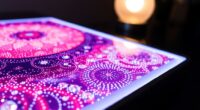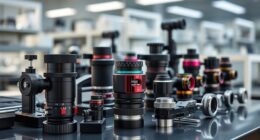If you’re looking to enhance lunar and planetary views, I recommend exploring a variety of colored filter sets like the Celestron, Neewer, SVBONY, and Alstar options. These sets include filters designed to boost contrast, reveal surface details, and add creative effects, all compatible with 1.25-inch eyepieces. They’re perfect for both beginner and amateur astronomers seeking better detail and stunning visuals. Keep going to discover the top picks and features that suit your stargazing needs.
Key Takeaways
- Look for filter sets that include a variety of colors like red, blue, green, yellow, and purple for versatile planetary enhancement.
- Choose sets with high-quality optical glass and anti-reflection coatings to ensure clear, detailed planetary views.
- Consider compatibility with 1.25-inch eyepieces and accessories for easy integration with most telescopes.
- Opt for durable, lightweight filters with threaded designs for stacking and customized effects during planetary observation.
- Prioritize sets with positive user reviews for contrast, glare reduction, and improved surface detail on planets.
Celestron Lunar and Planetary Eyepiece Filter Set (4 Pieces)

If you’re looking to improve your lunar and planetary views, the Celestron Lunar and Planetary Eyepiece Filter Set (4 Pieces) is an excellent choice for amateur astronomers seeking versatile, high-quality filters. This set includes Deep Yellow, Orange, Blue, and Neutral Density filters, all designed for 1.25-inch eyepieces. They effectively boost contrast, reduce glare, and enhance details on planets and the Moon. Made with durable, anti-reflection coated glass, these filters prevent ghosting and scratches. The double-threaded design allows stacking for customized effects, making them easy to use and adaptable. Overall, this set offers great value for sharper, clearer astronomical observations.
Best For: amateur astronomers and hobbyists seeking versatile, high-quality filters to enhance lunar and planetary observations with improved contrast and detail.
Pros:
- Made with durable, anti-reflection coated glass for clear, glare-free views
- Double-threaded design allows stacking for customizable effects and transmission control
- Compatible with most 1.25-inch eyepieces and telescopes, offering versatility
Cons:
- Filters can rotate easily during use, which may require adjustments
- Limited to the four included filters, offering less variety for specialized observations
- Slightly larger size may be less convenient for very compact eyepieces
Neewer Telescope Moon Filter and Color Filter Set
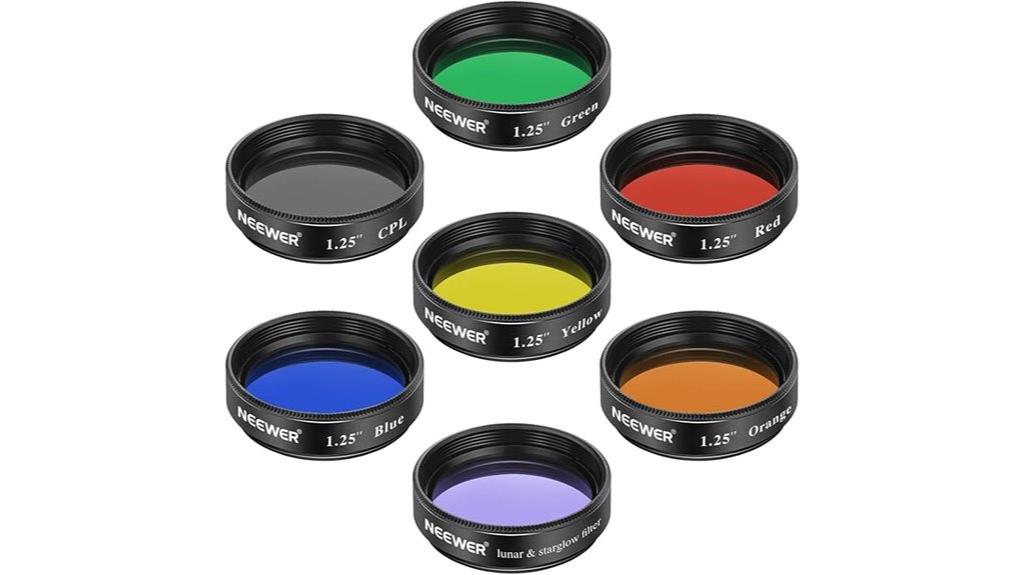
The Neewer Telescope Moon Filter and Color Filter Set is an excellent choice for amateur astronomers seeking versatile tools to enhance lunar and planetary viewing. This set includes a Lunar & Starglow Filter, CPL Filter, and five color filters—red, orange, yellow, green, and blue—designed to improve contrast, detail, and resolution. Compatible with most 1.25-inch telescopes, these filters reduce glare, light scattering, and irradiation, making planetary features more vivid. The filters are easy to screw into eyepieces thanks to their grooved design. With a high customer rating and affordable price, this set offers a practical way to elevate your lunar and planetary observations.
Best For: amateur astronomers and stargazing enthusiasts looking to enhance their lunar and planetary observations with versatile, easy-to-use filters.
Pros:
- Includes a variety of filters (Lunar & Starglow, CPL, and five color filters) for comprehensive observation enhancement
- Compatible with most 1.25-inch telescopes, ensuring broad usability
- Easy to attach thanks to grooved design, improving convenience during setup
Cons:
- May require additional accessories for use with larger or different telescope sizes
- Limited to 1.25-inch eyepiece compatibility, not suitable for telescopes with larger eyepiece diameters
- Some users might find the set less effective for advanced astrophotography compared to specialized filters
6pcs Round Color Lens Filter Set (52mm) with Pouch and Cleaning Tools
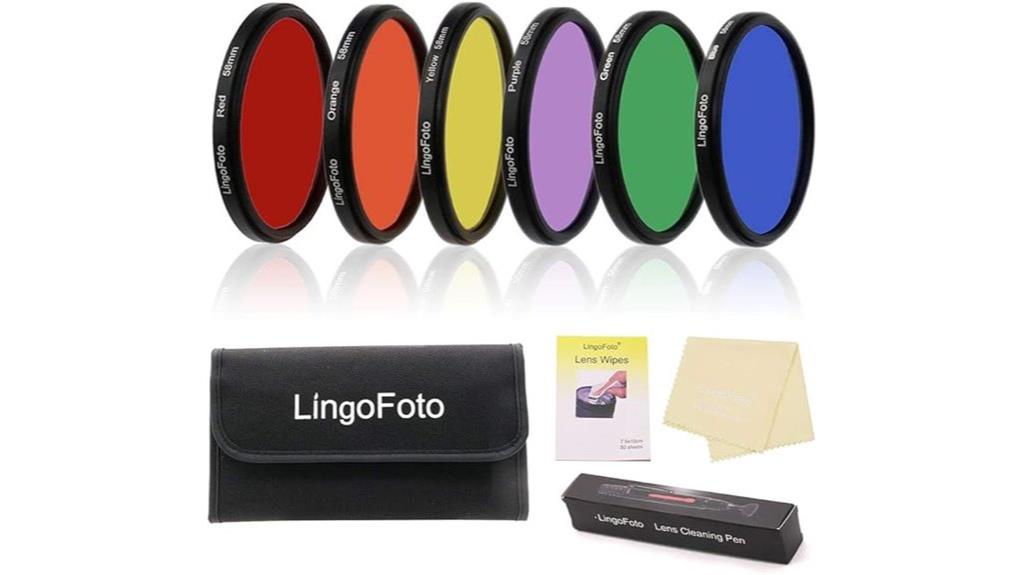
For photographers looking to add vibrant color effects to their images, the pcs Round Color Lens Filter Set (52mm) with Pouch and Cleaning Tools offers a versatile and easy-to-use solution. This set includes six full-color filters—red, orange, yellow, green, blue, and purple—that deliver smooth color progressions and enable creative blending. They’re double-threaded, so stacking with other filters is simple, expanding your options. Compatible with various 37mm lens models, the set also comes with a pouch and cleaning tools to keep your lenses spotless. With a solid 4.4-star rating and practical accessories, this filter set is perfect for enhancing landscape shots and mood.
Best For: photographers and videographers seeking vibrant color effects and creative blending options for landscape, portrait, or artistic photography.
Pros:
- Includes six full-color filters for versatile color effects and smooth transitions
- Double-threaded design allows stacking with other filters for expanded creative options
- Comes with a pouch and cleaning tools to maintain lens clarity and longevity
Cons:
- Only compatible with 37mm filter threads, limiting use with larger lenses
- May require additional filters for more complex effects or specific lighting conditions
- The set’s compact size and lightweight design might be less durable for rugged outdoor use
SVBONY Telescope Filter 1.25 inches Moon and CPL Filter Set (7pcs)
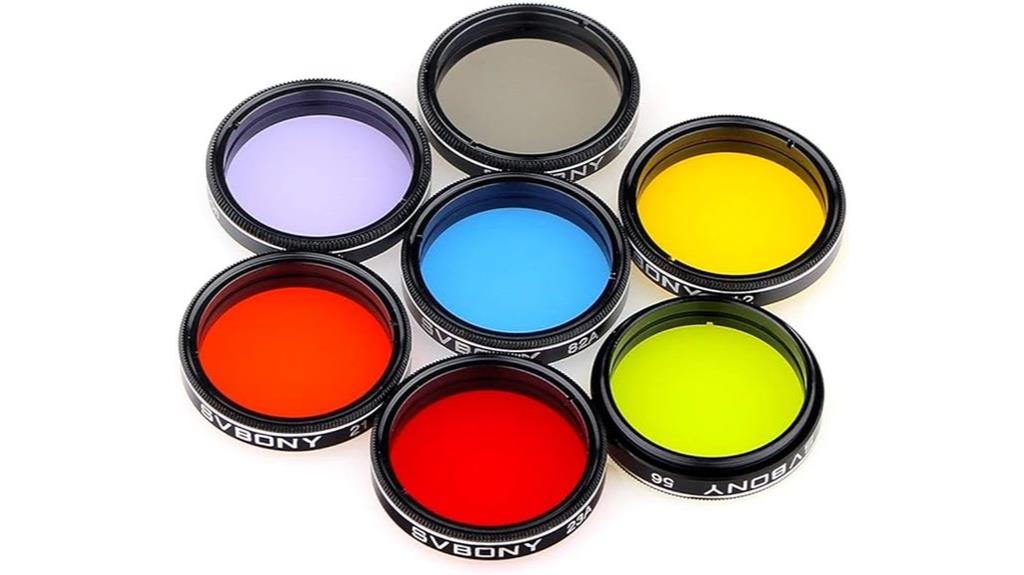
Designed for amateur astronomers seeking versatile and high-quality filters, the SVBONY Telescope Filter 1.25 inches Moon and CPL Filter Set offers an all-inclusive selection for lunar and planetary observation. This 7-piece kit includes a moon filter, CPL filter, and five color filters—red, orange, yellow, green, and blue—each in protective cases. Made with durable aluminum and optical glass, they fit standard 1.25” eyepieces and improve contrast, detail, and image clarity. Users praise their ease of use and solid construction, noting significant enhancements in lunar and planetary views. Overall, this set provides excellent value for enthusiasts aiming to elevate their stargazing experience.
Best For: amateur astronomers and stargazing enthusiasts seeking a versatile, high-quality filter set to enhance lunar and planetary observations.
Pros:
- Includes a comprehensive set of filters (moon, CPL, and five color filters) for versatile viewing options.
- Crafted with durable aluminum alloy frames and optical glass for longevity and clear images.
- Compatible with standard 1.25” eyepieces and easy to screw on, providing improved contrast and detail.
Cons:
- Some users note that filters may not be as clear as single-power lenses or may not stack effectively.
- The set may be less suitable for advanced astrophotography requiring specialized filters.
- Slightly larger filters might require careful handling to avoid cross-threading or damage.
Alstar Filter Set of 1.25-Inch Telescope Filters
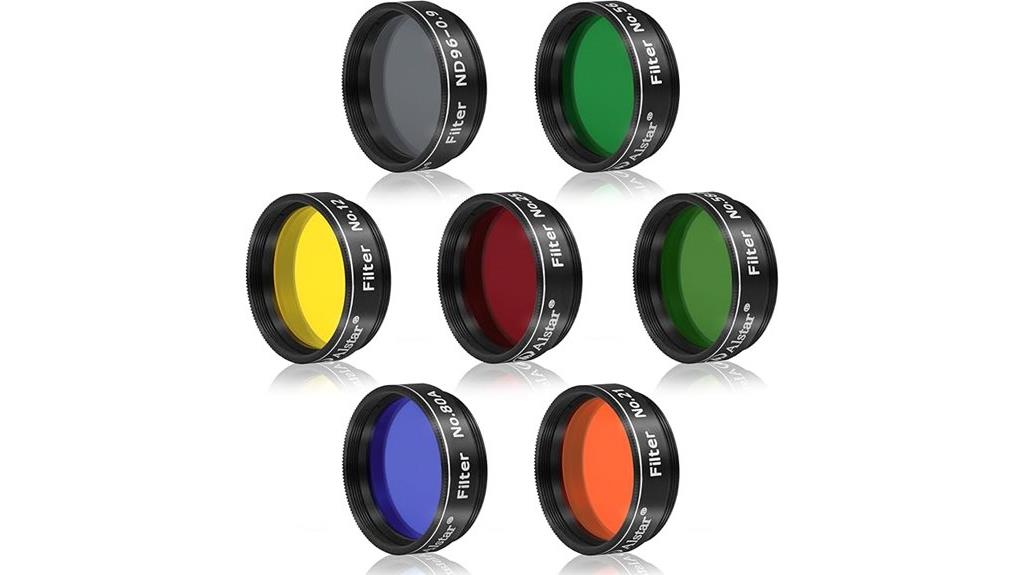
If you’re seeking an affordable yet reliable set of filters for planetary and lunar observation, the Alstar 1.25-Inch Filter Set delivers excellent value. It includes seven high-quality filters compatible with most 1.25-inch eyepieces, making it versatile for both visual viewing and astrophotography. Constructed with Schott optical glass and anti-reflection coating, these filters enhance detail and contrast. The set features six color filters—red, orange, yellow, green, blue, and dark green—and a moon filter, helping me reveal planetary features and lunar details more vividly. Compact and lightweight, this set offers great performance at a budget-friendly price, earning strong reviews from fellow enthusiasts.
Best For: Amateur astronomers and astrophotographers seeking an affordable, versatile set of high-quality filters for planetary and lunar observation with 1.25-inch telescopes.
Pros:
- Includes a comprehensive set of seven filters, suitable for both visual and photographic use.
- Constructed with high-grade Schott optical glass and anti-reflection coating for enhanced clarity and contrast.
- Compact, lightweight design makes it easy to handle and compatible with most 1.25-inch eyepieces.
Cons:
- Limited to 1.25-inch filter size, not compatible with larger telescope eyepieces.
- The set may lack specialized filters needed for advanced astronomical imaging.
- Some users might find the color filters less effective under certain atmospheric conditions.
Alstar 5Pcs Telescope Filters Kit (Orange, Green, Yellow, Blue, Moon/Skyglow)

The Alstar 5Pcs Telescope Filters Kit stands out as an excellent choice for amateur astronomers seeking to enhance their planetary observations and astrophotography. This set includes orange, green, yellow, blue, and moon/skyglow filters, each designed to improve contrast, clarity, and detail. The high-grade Schott optical glass guarantees sharp images, while anti-reflection coatings maximize light transmission. The ultra-thin metal holder minimizes shadows and diffraction, making it easy to attach to 1.25-inch eyepieces. Whether you’re capturing lunar details or reducing atmospheric interference, this kit provides versatile filters that elevate your stargazing experience. It’s a reliable, well-rated option for serious hobbyists.
Best For: amateur astronomers and astrophotographers seeking to enhance planetary observation and sky imaging with versatile, high-quality filters.
Pros:
- Includes a variety of filters (orange, green, yellow, blue, moon/skyglow) for comprehensive observation needs.
- Made from high-grade Schott optical glass with anti-reflection coatings for optimal light transmission and sharp images.
- Ultra-thin metal holder design reduces shadows and diffraction, ensuring easy attachment to 1.25-inch eyepieces.
Cons:
- The set may be less suitable for advanced astrophotographers requiring specialized or narrowband filters.
- Slightly limited to 1.25-inch filter size, which might not fit larger or newer telescope models.
- Only five filters included, which might require additional purchases for specific imaging requirements.
Astromania 3-Piece Planetary Imaging Filter Set (UV/Methane/IR)

Astromania’s 3-Piece Planetary Imaging Filter Set is perfect for astrophotographers who want to capture detailed planetary images using monochrome cameras. It includes UV, IR, and methane (CH4) filters that pass wavelengths outside visible light, enhancing planetary features. The UV filter reveals atmospheric structures, while the IR filter improves clarity and steadiness during poor seeing conditions. The methane filter, at 890nm, uncovers high-altitude atmospheric phenomena and boosts contrast. Compact and lightweight, the set comes in a protective case, making it ideal for high-contrast, detailed planetary imaging. It’s especially useful when working with monochrome cameras to maximize image quality.
Best For: astrophotographers using monochrome cameras aiming to capture high-contrast, detailed planetary images under varying atmospheric conditions.
Pros:
- Enhances planetary details by passing specific wavelengths outside visible light for improved contrast.
- Compact, lightweight design with protective case for easy portability and storage.
- Improves image clarity and steadiness during poor seeing conditions, especially with IR filter.
Cons:
- Designed exclusively for monochrome cameras, limiting compatibility with color imaging setups.
- Narrowband methane filter at 890nm may require specialized knowledge for optimal use.
- Limited to planetary imaging; not suitable for deep-sky astrophotography or color imaging without additional filters.
Astromania 1.25-Inch Telescope Filter Set (7 Filters)
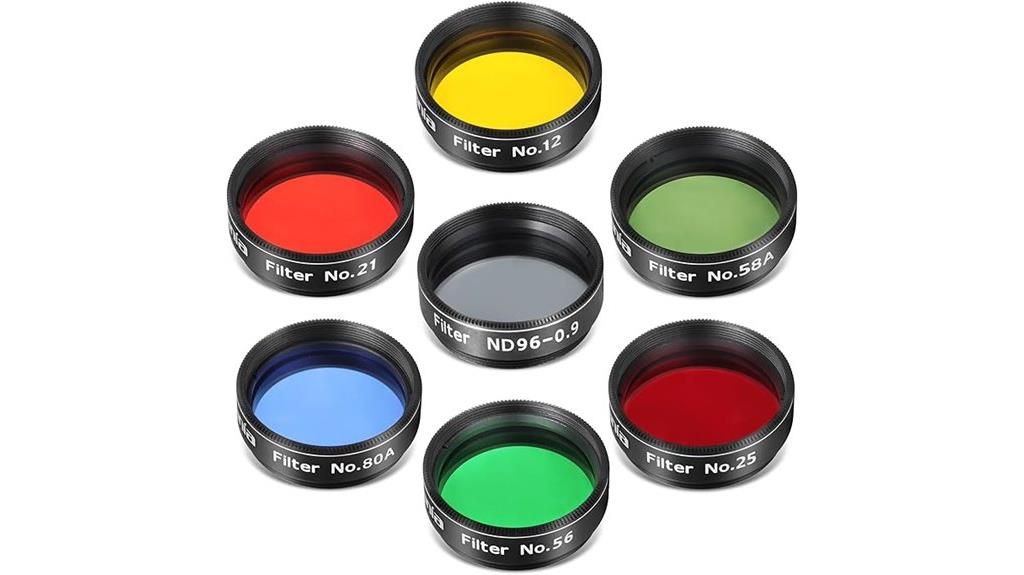
Designed for amateur astronomers seeking versatile and durable filters, the Astromania 1.25-Inch Telescope Filter Set offers six vibrant color filters plus a moon filter, all threaded for easy compatibility with standard eyepieces. These filters include red, orange, light yellow, dark green, blue, and green, along with a moon filter, making it ideal for enhancing planetary and lunar details. Crafted from high-grade Schott optical glass with anti-reflection coating, they maximize light throughput while minimizing diffraction. The metal filter cells ensure durability and secure fitting. Whether for visual observation or astrophotography, this set provides excellent value and detailed, vivid views of celestial objects.
Best For: Amateur astronomers and astrophotographers looking for versatile, durable filters to enhance planetary and lunar observations.
Pros:
- Includes a comprehensive set of six vibrant color filters plus a moon filter for versatile viewing options
- Made from high-grade Schott optical glass with anti-reflection coating, ensuring maximum light throughput and durability
- Threaded design allows easy compatibility with standard 1.25-inch telescope eyepieces and accessories
Cons:
- Only compatible with 1.25-inch eyepieces, limiting use with larger telescope systems
- May require additional filters or accessories for specialized astrophotography needs
- Metal filter cells, while durable, can be more expensive to replace if damaged
Astromania 1.25 Color/Planetary Filter – #23A Red

If you’re looking to enhance your lunar and planetary observations, the Astromania 1.25″ #23A Red Filter is an excellent choice. It threads easily into any 1.25″ eyepiece and is mounted in a durable anodized housing. This filter is especially useful for large aperture telescopes, where the Moon’s brightness can be overwhelming. It enhances contrast and detail on lunar and planetary surfaces without altering their natural colors, making it ideal for both visual observation and astrophotography. Overall, it’s a simple yet effective tool to bring out subtle features that might otherwise go unnoticed.
Best For: amateur astronomers and astrophotographers seeking to enhance lunar and planetary contrast through visual observation or imaging.
Pros:
- Improves contrast and detail on lunar and planetary surfaces without altering natural colors
- Easy to install, threading into any 1.25″ eyepiece
- Durable anodized housing ensures long-lasting use
Cons:
- Only compatible with 1.25″ eyepieces, limiting versatility for larger telescope setups
- May slightly dim the view, requiring adjustments for optimal brightness
- Not suitable for use with very high-power magnifications where additional contrast may be less noticeable
6pcs Telescope Eyepiece Filters Set
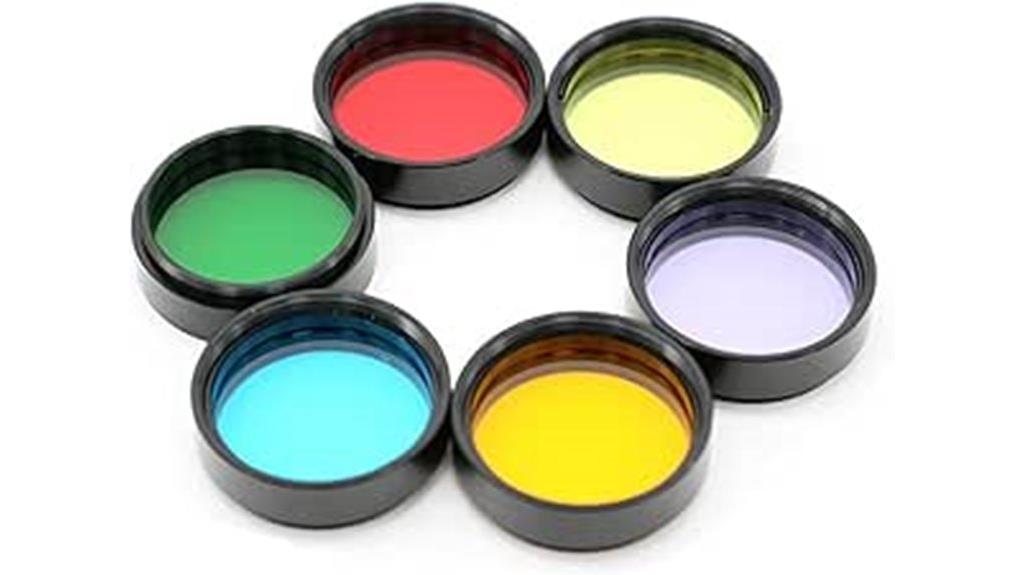
The 6pcs Telescope Eyepiece Filters Set is an excellent choice for amateur astronomers looking to enhance their planetary observations. This set includes six vibrant colored filters—red, green, yellow, orange, blue, and purple—designed to bring out finer details on planets like Mars, Jupiter, and Saturn, as well as lunar features. Made with durable aluminum alloy frames and optical glass lenses, they’re compatible with standard 1.25-inch eyepieces. Lightweight and easy to attach or remove, these filters improve contrast and highlight specific features, making your night sky viewing more stunning and detailed. It’s a versatile, affordable set perfect for both beginners and seasoned stargazers.
Best For: amateur astronomers and telescope enthusiasts seeking to improve planetary and lunar observations with easy-to-use, colorful filters.
Pros:
- Enhances contrast and details on planets and the Moon for clearer viewing.
- Made with durable aluminum alloy frames and optical glass lenses for quality and longevity.
- Compatible with standard 1.25-inch eyepieces, making them versatile and easy to attach or remove.
Cons:
- Limited to 6 colors, which may not cover all observational needs.
- Slightly lightweight construction may require careful handling during use.
- Only compatible with 1.25-inch threaded eyepieces, not larger or different sizes.
1.25 Inches Telescope Moon Filters Set (6 Colors)

For amateur astronomers seeking versatile lunar observation tools, the 5 Inches Telescope Moon Filters Set with six vibrant colors offers an excellent solution. This set includes yellow, orange, red, light green, blue, and light violet filters, all designed to fit 1.25-inch eyepieces on any telescope. They’re easy to install and can be used alone or stacked for customized effects. Made of optical glass and plastic, they’re lightweight and portable, with a handy storage box. These filters markedly reduce glare and enhance contrast on the lunar surface, revealing fine details and improving overall viewing quality, making them a must-have for lunar enthusiasts.
Best For: amateur astronomers and lunar enthusiasts seeking versatile, high-quality filters to enhance planetary and lunar observations with 1.25-inch telescopes.
Pros:
- Includes six vibrant color filters to customize viewing experiences
- Reduces glare and enhances contrast, revealing fine lunar details
- Lightweight, portable, and easy to install on any 1.25-inch telescope
Cons:
- May require stacking filters for certain effects, which can be cumbersome
- Limited to 1.25-inch eyepieces; not compatible with larger sizes
- Color filters primarily benefit specific planetary and lunar features, less effective for deep-sky objects
Alstar Eyepiece & Filter Accessory Kit for Astronomy
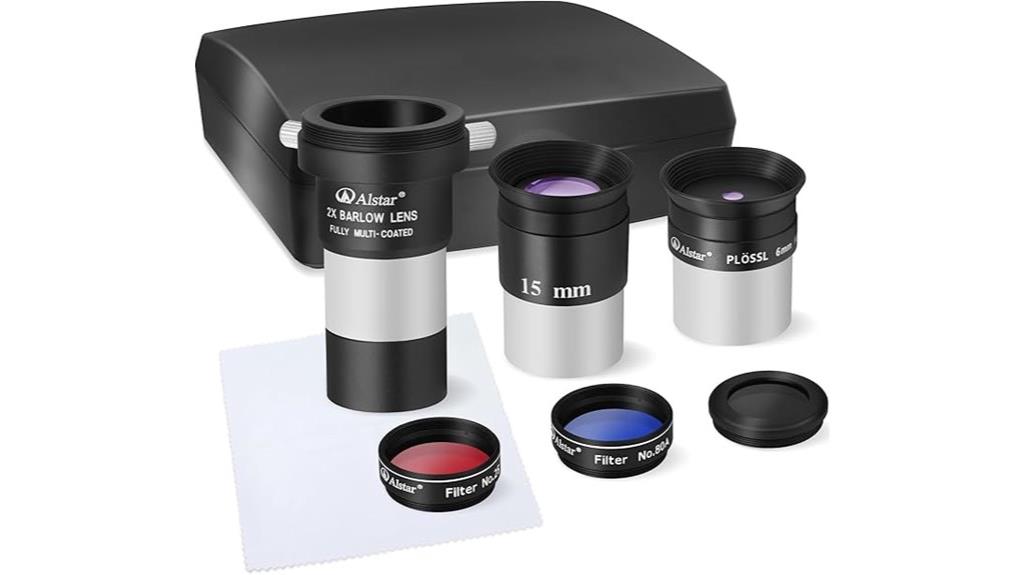
Designed with beginners in mind, the Alstar Eyepiece & Filter Accessory Kit offers essential tools that considerably enhance planetary and lunar observations. It includes two fully-coated eyepieces (15 mm and 6 mm) for wide and detailed views, plus a 2x Barlow lens to double magnification and support astrophotography. The kit also features three filters—a lunar filter and two color filters—to boost contrast and surface detail. All components come in a sturdy, foam-lined case with a cleaning cloth, making it convenient for field use. This exhaustive set helps novice astronomers explore the night sky with improved clarity and versatility.
Best For: beginner astronomers seeking a comprehensive, portable kit to enhance lunar, planetary, and deep-sky observations with easy-to-use accessories.
Pros:
- Includes essential fully-coated eyepieces and filters for versatile viewing experiences.
- Comes with a durable, foam-lined carry case for convenient outdoor use and storage.
- Supports astrophotography with a 2x Barlow lens and T-thread for camera mounting.
Cons:
- Limited to entry-level telescopes; may not satisfy advanced amateur astronomers.
- Only two eyepieces, which might require additional accessories for more specialized viewing.
- The kit’s compact size may restrict the number of additional accessories or tools included.
Telescope Moon Filter Set (6 Colors, 1.25 inches)
https://m.media-amazon.com/images/I/414-kb5Ed+L.jpg
If you’re new to astronomy or enjoy casual stargazing, the Telescope Moon Filter Set with six vibrant colors is an excellent choice. These 1.25-inch filters enhance image contrast, making lunar details pop during your observations. Made from durable aluminum alloy optical glass, they provide clear, reliable views. Suitable for both adults and kids, they work with various telescope types, including portable and beginner models. The set includes red, orange, yellow, green, blue, and purple filters, offering versatile options for different lighting conditions and effects. Plus, each filter comes in its own packaging, making it easy to organize and carry on your stargazing adventures.
Best For: beginner astronomers, children, and casual stargazers looking to enhance lunar observations with versatile, colorful filters.
Pros:
- Enhances image contrast and lunar detail during observation
- Made from durable aluminum alloy optical glass for clarity and longevity
- Comes with six vibrant color filters, suitable for various lighting conditions
Cons:
- Designed specifically for 1.25-inch telescope fittings, limiting compatibility with larger sizes
- May require additional adapters for some telescope models
- Not suitable for professional or high-precision astrophotography
Astromania Telescope Accessory Kit (1.25 Inch)
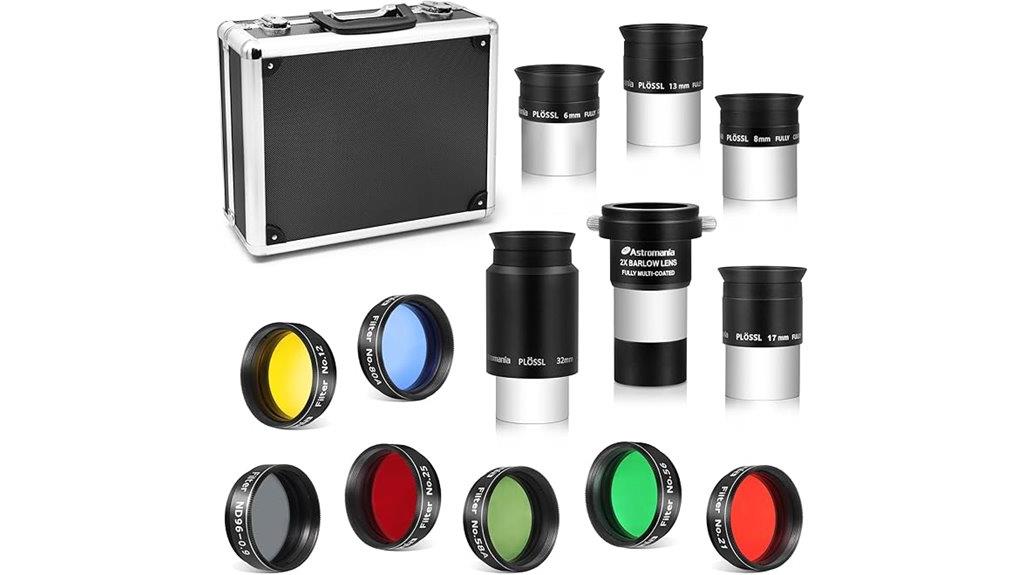
The Astromania Telescope Accessory Kit (1.25 Inch) stands out as an all-encompassing choice for amateur astronomers seeking versatile planetary observation tools. It’s compatible with all standard 1.25-inch telescopes and features high-grade, fully multicoated glass optics for clear images. The kit includes five premium Plossl eyepieces with focal lengths from 6mm to 32mm, plus a 2x Barlow lens that doubles magnification. It also offers six colored filters for planetary and lunar detail, along with a Moon filter for comfortable viewing during bright phases. All components are stored securely in a durable, lockable aluminum case, making it a great value for enthusiasts.
Best For: amateur astronomers and stargazing enthusiasts seeking a comprehensive, versatile telescope accessory kit compatible with standard 1.25-inch telescopes.
Pros:
- Includes a complete set of high-quality Plossl eyepieces and a 2x Barlow lens for a wide range of magnifications.
- Comes with multiple colored filters and a Moon filter to enhance planetary and lunar observations.
- Stored securely in a durable, lockable aluminum case for easy transportation and organization.
Cons:
- May be less suitable for advanced astronomers requiring specialized or higher-end accessories.
- The kit’s weight and size might be cumbersome for very portable setups.
- Limited to standard 1.25-inch accessories, not compatible with larger-sized telescope fittings.
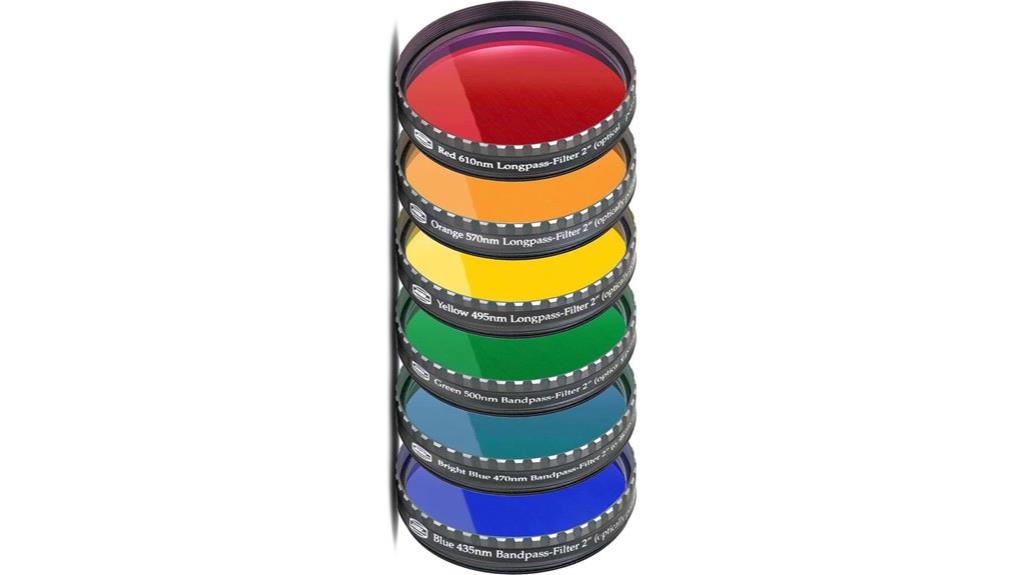
For serious astronomers seeking high-quality planetary filters, the Baader Premium Eyepiece Filter set offers exceptional performance with six precision-crafted color filters. These filters enhance contrast, detail, and isolation on planets, making observations more vivid and informative. Crafted with striae-free substrates and 7-layer multicoatings, they minimize ghosting and image degradation, even at high magnifications. The 2-inch size simplifies binoviewing and stacking, providing versatility for both visual and digital imaging. Whether used individually or together, these filters deliver sharp, high-contrast images across various telescopes, making them an excellent addition for anyone dedicated to detailed planetary observation.
Best For: Serious amateur and professional astronomers seeking high-quality, versatile planetary filters for enhanced contrast and detail in observation and imaging.
Pros:
- High optical quality with striae-free substrates and 7-layer multicoatings for minimal ghosting and image degradation
- Versatile 2-inch size simplifies binoviewing, stacking, and compatibility across various telescopes and imaging setups
- Designed to maximize contrast and detail with spectral passbands optimized for planetary observation and digital imaging
Cons:
- May be more expensive than standard or lower-quality filters
- Limited to planetary observation and imaging, less suitable for deep-sky objects
- Requires proper handling and stacking for optimal performance, which may be complex for beginners
Factors to Consider When Choosing Planetary Filters Colored Set
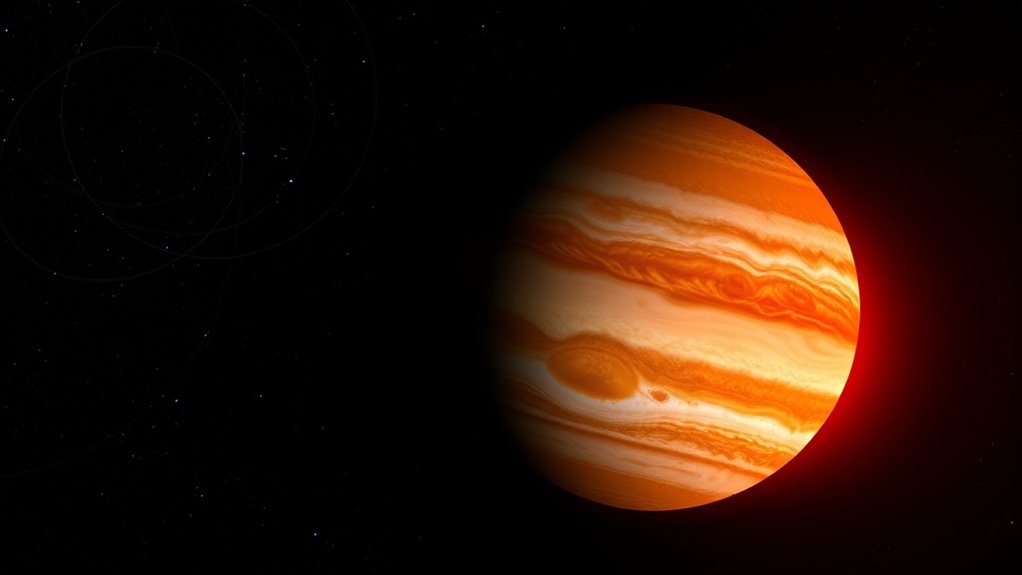
When selecting a planetary filter set, I consider several key factors to guarantee I get the best performance. Things like the filter’s wavelength range, compatibility with my equipment, and durability matter a lot. I also look at ease of use and how the price balances with the overall value.
Filter Wavelength Range
Choosing the right planetary filter set hinges on understanding its wavelength range, as this determines which parts of the spectrum are transmitted or blocked. This affects the contrast and detail visible on planetary surfaces. Filters focusing on narrow bands—like red (600–700 nm), green (500–560 nm), or blue (450–495 nm)—are designed to highlight specific features such as surface markings or atmospheric details. Broader filters, such as neutral density or polarizers, transmit wider wavelengths to reduce brightness without changing color, improving contrast. The effectiveness of a filter is often shown by its spectral transmission percentage; higher percentages mean brighter, clearer images. Knowing the wavelength range helps me choose filters tailored to reveal particular planetary features like polar caps, cloud belts, or surface markings.
Compatibility With Equipment
Selecting planetary filters that are compatible with your equipment is essential to guarantee ideal performance and image quality. First, check that the filter set has standard 1.25-inch or 2-inch threaded mounts that fit your telescope’s eyepieces or accessories. Confirming compatibility prevents frustrating fitting issues during observation. Next, verify the filter material and construction meet high optical standards, like optical glass and anti-reflection coatings, to avoid image degradation. It’s also important to confirm that the spectral transmission matches your observation goals, such as enhancing planetary details at specific wavelengths. Additionally, ensure the filters include the right types—moon, planetary, or color filters—that suit your equipment’s specifications. Lastly, review stacking options to avoid ghosting or loss of sharpness when combining multiple filters for customized views.
Durability and Coatings
Durability and coatings are indispensable factors that directly impact the longevity and performance of planetary filters. High-quality filters feature anti-reflection coatings that reduce glare and ghosting, resulting in clearer images. They’re made from optical glass with scratch-resistant coatings, helping them withstand regular use without damage. Multi-layer coatings boost light transmission and contrast, which is essential for detailed planetary views. Proper coatings also prevent internal reflections and image artifacts, enhancing clarity and color accuracy. Filters with robust coatings are less vulnerable to scratches, corrosion, and environmental damage, extending their lifespan. Investing in durable filters ensures consistent performance over time, saving you money and frustration. Ultimately, these coatings preserve image quality and protect your equipment, making them an indispensable consideration when choosing a planetary filter set.
Ease of Use
When it comes to ease of use, the design and features of planetary filters can make a significant difference in your observing experience. I recommend choosing filters with standard 1.25-inch threading to guarantee compatibility with most telescopes and eyepieces. Look for those with easy-to-grip, double-threaded cells that let you stack filters effortlessly without extra tools. Selecting sets with clear aperture sizes around 26mm or 27mm helps maximize light transmission and keeps images bright. Anti-reflection coatings are essential to prevent glare and ghosting, enhancing clarity. Additionally, color-coded or engraved markings simplify quick identification and switching between filters during observation. These features streamline your viewing sessions, making it easier to enjoy stunning planetary details without hassle.
Cost and Value
Choosing the right planetary filter set involves balancing cost with the features and performance you need. Prices range from under $20 for basic sets to over $100 for premium options, affecting overall value. Higher-priced sets often include better optical coatings, increased durability, and more precise spectral passbands, making them ideal for serious astronomers. However, even budget-friendly sets can improve contrast and planetary details for casual observers, offering a cost-effective upgrade. It’s crucial to consider the number of filters and their spectral properties to ensure the set matches your observational goals. Comparing price-to-benefit ratios—taking into account filter quality, coatings, and accessories—helps you select a set that offers the best value for your investment and enhances your stargazing experience.
Frequently Asked Questions
How Do Colored Filters Enhance Planetary Surface Details?
Colored filters improve planetary details by increasing contrast and highlighting specific surface features. They block certain wavelengths of light, making details like cloud patterns on Jupiter or surface markings on Mars stand out more clearly. I find that using these filters helps me see subtle variations that are often hidden under normal viewing conditions. They’re especially useful for emphasizing features that are otherwise difficult to distinguish, enhancing the overall clarity of my astronomical observations.
Which Filter Type Is Best for Observing Planetary Atmospheres?
I recommend using a yellow or orange filter when observing planetary atmospheres. These filters help reduce glare and enhance contrast, making atmospheric details like cloud bands and storms more visible. They improve the overall clarity by filtering out specific wavelengths, allowing you to see subtle features more clearly. I’ve found that experimenting with different filter densities can also reveal interesting atmospheric phenomena, making your viewing experience more rewarding.
Can Filters Improve Lunar Surface Features Visibility?
Yes, filters can definitely improve lunar surface features visibility. I find that using neutral or lunar filters enhances contrast, making craters and maria stand out more clearly. By reducing glare and increasing details, filters help me see subtle differences in surface textures. I recommend trying different filters to see which ones bring out the features you’re most interested in, especially during full or near-full moon phases.
Are Certain Filters Better Suited for Astrophotography?
Coincidentally, some filters are definitely better for astrophotography because they enhance specific details and improve contrast. I find that narrowband filters, like H-alpha and OIII, work wonders for capturing deep-sky objects, while color filters can bring out subtle features on planets. Choosing the right filter depends on your target, but investing in high-quality options often results in sharper, more vibrant images. I recommend testing different filters to find what best complements your equipment and goals.
How Do Light Pollution Filters Affect Planetary Viewing?
Light pollution filters improve planetary viewing by reducing the glare from city lights and enhancing contrast. I notice clearer details and more vibrant planets when I use one, especially in areas with moderate light pollution. They don’t block out all light, so I can still see the planets clearly, but they make the features pop. If you’re in a light-polluted area, these filters can make a significant difference in your viewing experience.
Conclusion
Choosing the right colored planetary filter set can truly enhance your stargazing experience, revealing details you might miss otherwise. I get it—cost and selection can feel overwhelming. But remember, even a basic set can transform your views and deepen your appreciation for the cosmos. Don’t let hesitation hold you back; investing in filters is a small step toward breathtaking, unforgettable astronomical adventures. Trust me, the universe looks even more amazing through the right filters.

